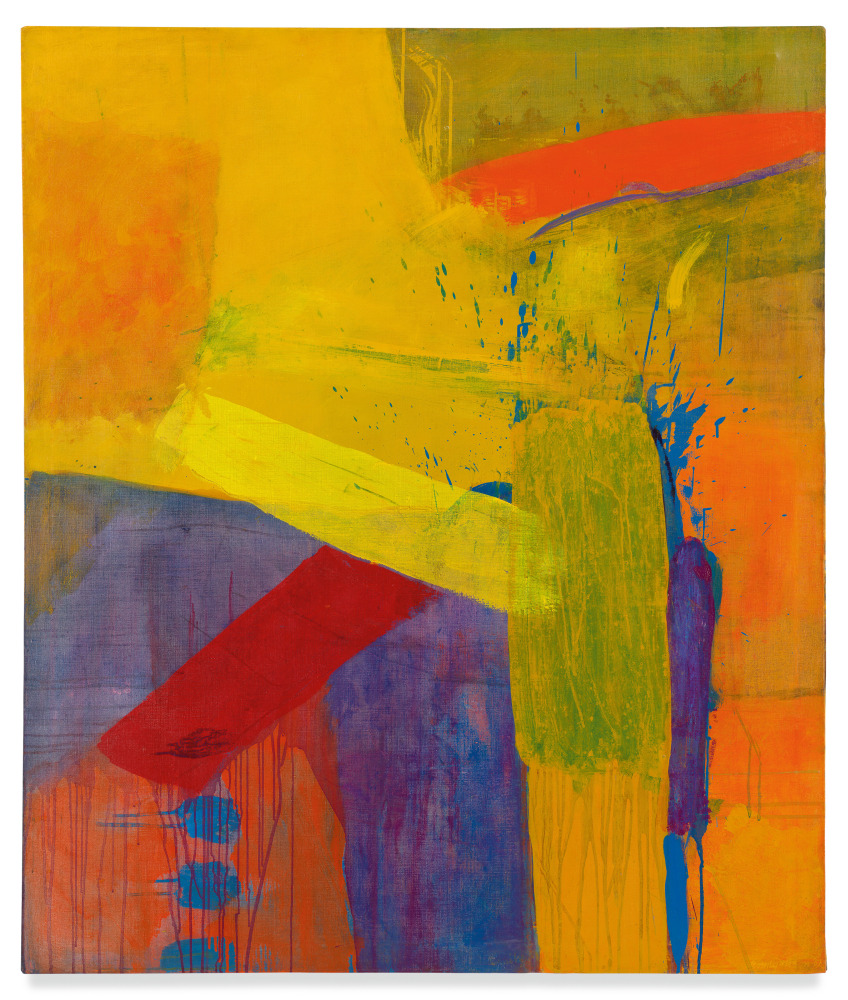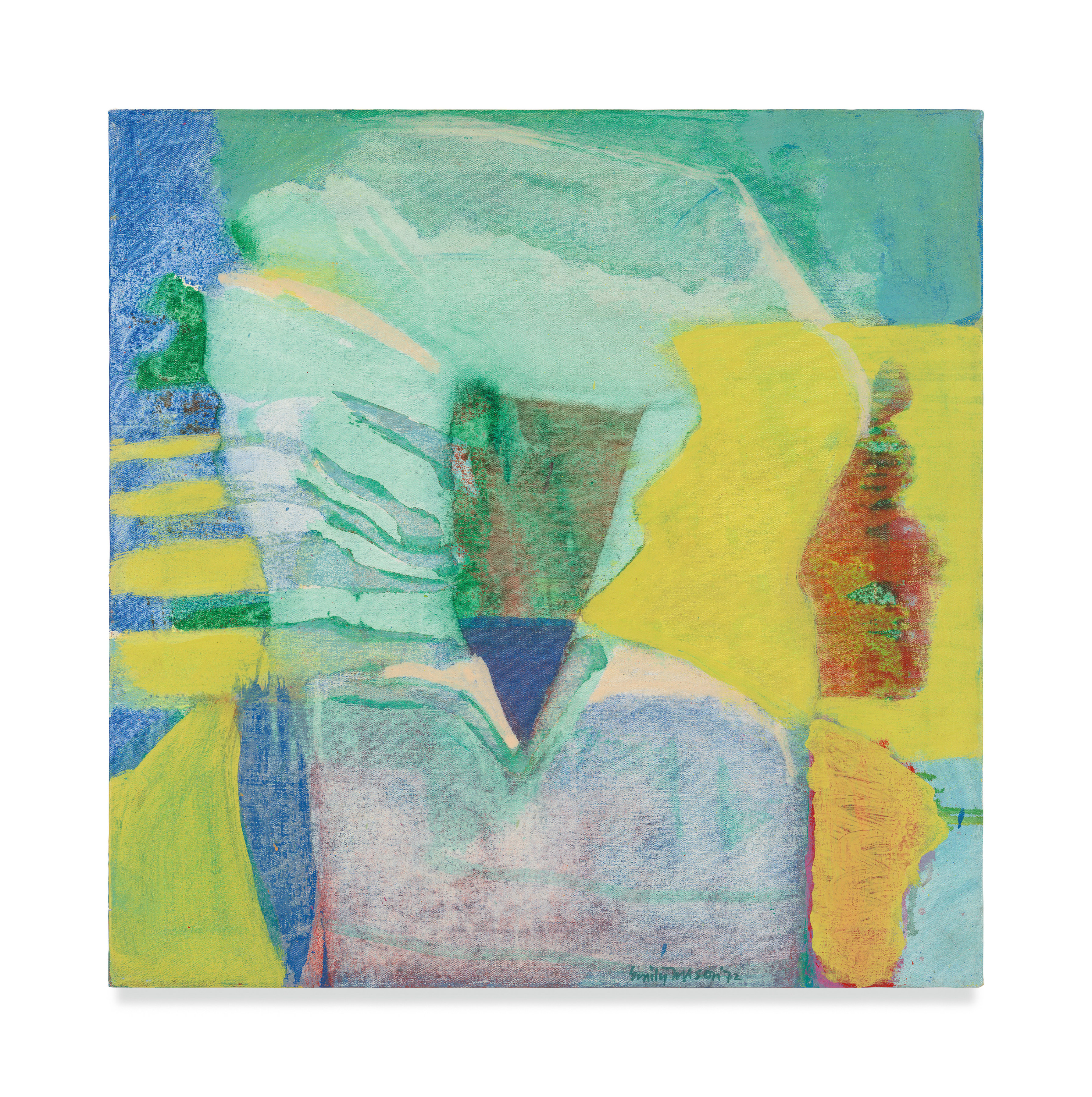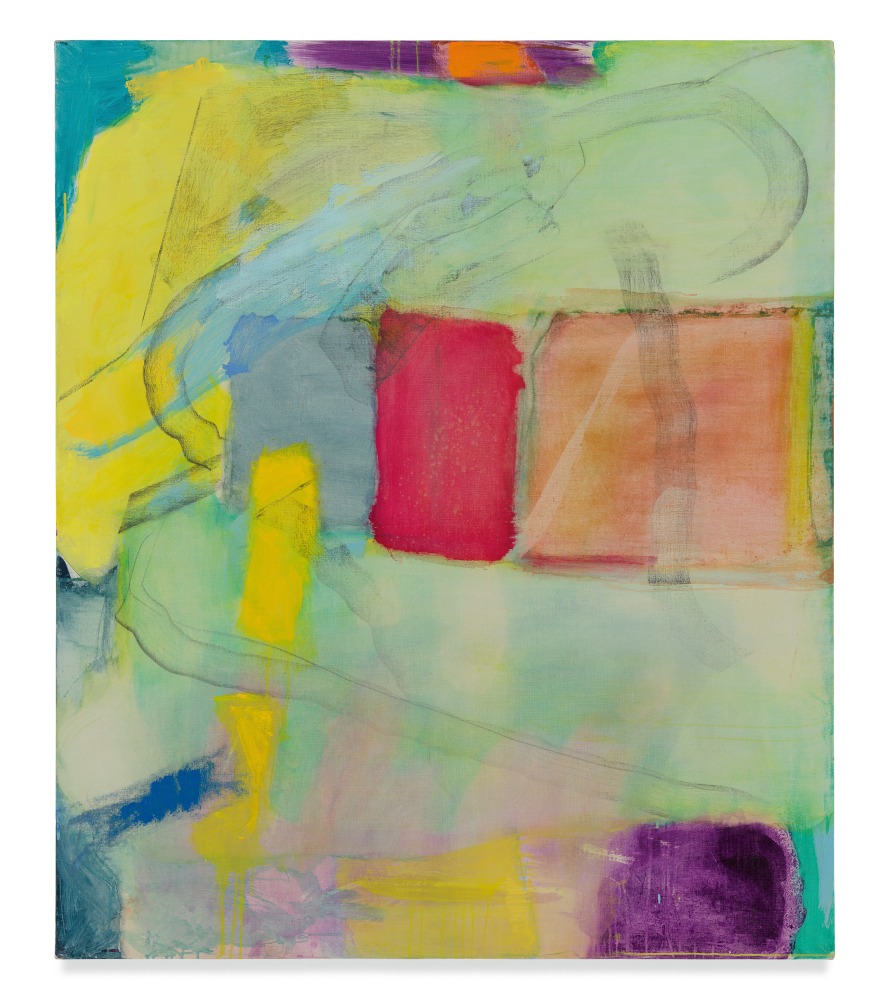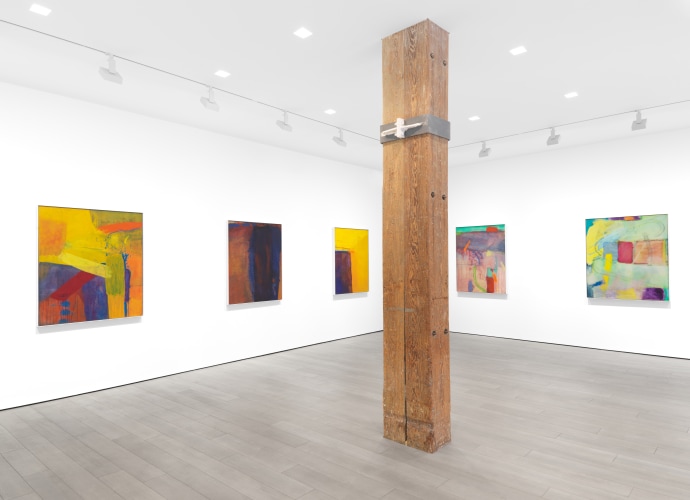
EMILY MASON | THE NEW YORKER
NO ONE PAINTED COLOR LIKE EMILY MASON
17 JANUARY 2024

Pleasure Garden, 1970, Oil on canvas
52 x 44 inches, 132.1 x 111.8 cm
This may sound like an insult, and in fact many of the finest Mason paintings are very close to the third-rate ones. (Sanity has a tiny margin of error.) Her technique is always in danger of coming across as too pat, but that’s part of what makes it so thrilling when it pays off. Working your way from the left to the right side of the small, square “Like Some Old Fashioned Miracle” (1972-74), you first find bright yellow and blue cheek to cheek with hunter green, simple as two plus three equals five. In the center, everything goes wonky. The blue ripens, the shade of green switches from hunter to rusty penny, and the yellow disappears altogether, only to emerge on the other side bearing a little penny rust itself. The shapes are solid-looking for the most part but a little fuzzy around the edges, as though eroded by the elements. (Again, I detect the influence of that trip to Lascaux.) As usual, the painting’s title comes from Dickinson, but I’m reminded more strongly of the Song-dynasty poet Wei T’ai, who accidentally summed up Mason’s whole raison d’être when he said that poetry “should be precise about the thing and reticent about the feeling.”
The wonder of this painting is that, by not trying to overwhelm, Mason overwhelms. Time, and the way it chews at the grand and the modest with the same appetite, is her subject. Even as she sets out to deal with it frankly, she can’t help but transmit strong feeling; for me, it’s something like the melancholy jolt of rummaging through the closet and finding an old, yellowing diary. Mason was not an especially innovative artist. She pioneered no major aesthetic school, and, although she taught painting at Hunter College for more than thirty years, has no obvious imitators on the scene today. She’s just the person who made “Like Some Old Fashioned Miracle,” and that should be—and should have been—more than enough. ♦
— Jackson Arn
Published in the print edition of the January 29, 2024, issue, with the headline “Tone Control.”

Quiet Fog, 1976, Oil on canvas
22 x 18 inches, 55.9 x 45.7 cm
"Why isn’t she more famous?” The question has bugged me since I first saw the work of Emily Mason, one of the most ravishing post-New York School abstract painters, and my nominee for the most underrated. Not that these things are ever very fair; it’s just bizarre that an artist who knew everyone, and whose family everyone knew, ended up so close to unknown. Her distant ancestor John Trumbull painted a portrait of Alexander Hamilton that should look familiar to anyone who’s handled a ten-dollar bill, and her mother, the abstract painter Alice Trumbull Mason, hung out with Jackson Pollock and Helen Frankenthaler. Many artists have deserved glory, but few of them had Elaine de Kooning for a babysitter. Where’s nepotism when you need it?
The simplest explanation is that Mason, who died in 2019, at the age of eighty-seven, was born a generation too late for stardom. By the time she’d come into her own—the early Reagan years, I would say—abstract painting’s stock was sagging. To make matters worse, she shows every sign of having been the most embarrassing thing an American painter can be: sane. When deciding who belongs in the pantheon, we like a wild life at least as much as good art, and on this count, alas, Mason failed to deliver—not a single affair with Clement Greenberg or drunken piss at a party. “One of the least angry people I’ve ever known,” the critic David Ebony said, “and least bitter about things that had gone wrong for her in the art world.” I’m not trying to be rude, but she and the artist Wolf Kahn, her husband of sixty-plus years, appear to have had a happy, stable marriage. The juiciest gossip I could find: at first, Mason’s mother was surprised that she’d chosen to cohabit with a figurative painter.

Like Some Old Fashioned Miracle, 1972-1974
Oil on canvas, 24 x 24 inches, 61 x 61 cm
In her art, as in her life, clearheadedness was the rule. At “The Thunder Hurried Slow,” the second Mason exhibition at Miles McEnery since her death, the oil paintings astonish but never quite swoon with the effort; their breathing is more level. Most are medium-sized and seem not only painted but built, with lots of sturdy squarish shapes inlaid in the frame. Any seventh grader can tell you that a diagonal line conveys movement, but in “Pleasure Garden” (1970) the snug carpentry of two central slashes, one yellow and one red, keeps things static and holds the painting steady—if you shook it hard, nothing would fall out. (Even the blue splatter in the upper right seems fastened securely in place.) Depending on your predilections, the title might sound like a misnomer, but there’s a lot of pleasure to be had in crisply balanced moderation, just not the kind that tends to turn living artists into legends. Mason was named for a great American poet, and she named many of her paintings for this poet’s phrases, so here’s the inescapable analogy: if Pollock was the rollicking Walt Whitman of American abstract art, she was its Emily Dickinson.
With Mason, you come and stay for the colors. She prepared them in cat-food tins, stirring and diluting until they were ready to be poured over the canvas and shaped with a brush or, sometimes, a T-shirt or a finger. At their best, they feel both surprising and inevitable; at their worst, they are merely very, very nice to look at. The earliest work in “The Thunder Hurried Slow” was completed in 1968, the latest in 1979, and there is something more than a little seventies about the mold and mustard hues on display. I learned from the exhibition catalogue that Mason visited the cave paintings at Lascaux in her early twenties; this tidbit seems almost too on the nose for an artist who made paint look old and vibrant at once.

A Paper of Pins, 1974, Oil on canvas
52 1/4 x 44 1/4 inches, 132.7 x 112.4 cm
It’s a rare art show that evokes both stagflation and the prehistoric, but Mason’s work inspires this kind of free-associating. You can’t stare at her colors without feeling a twitch of recognition—clocking their turquoise and terra-cotta, I felt more like a native Southwesterner than I had in a while—and you can’t keep staring without those initial impressions slipping away. I sometimes get the idea that, for Mason, color was a form of storytelling: a pink feels like a plot twist, an orange like a blunt ending. I enjoy her paintings most when she makes an unlikely pair of colors scrape against each other and then smooths things over with a third. In “Greener Lean” (1978), the odd couple are a thick, too sugary green and a sickly yellow, and the deus ex machina is a drizzle of red in the lower right, which gives the yellow a little life and the green a little nuance. And I’m not sure I can say why the royal purple poking out of the sides of “A Paper of Pins” (1974) hits me so hard. It gives me the same quiet shock as the legs poking out of the sea in the Northern Renaissance masterwork “Landscape with the Fall of Icarus”: the sense that the big, operatic things in life will always be happening somewhere else, and that this is maybe for the best.
When Mason’s paintings come up short, it’s usually because they are trying too hard to be uncontrolled and can’t shake their nature. Sanity goes slumming but tricks nobody. “Defiant of a Road” (1972) has too much going on and not enough—the colors talk over one another as they wait for a resolution that never arrives. “Quiet Fog” (1976) does have something like a resolution; I just don’t buy it. Yellow and red and blue melt into the same shimmery gray, so that nothing specific to the drama between one color and its co-stars gets worked out—if this were the ending of a movie, it would be “It was all a dream!” The painting may be the most illuminating one in the exhibition, though, clarifying what succeeds in a Mason by demonstrating what doesn’t. It trails off suggestively, and Mason’s style works best when it says what it’s trying to say without a stutter.
